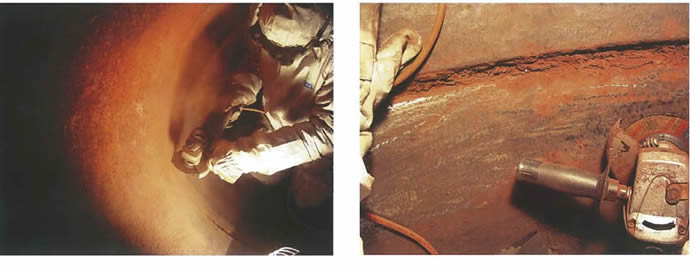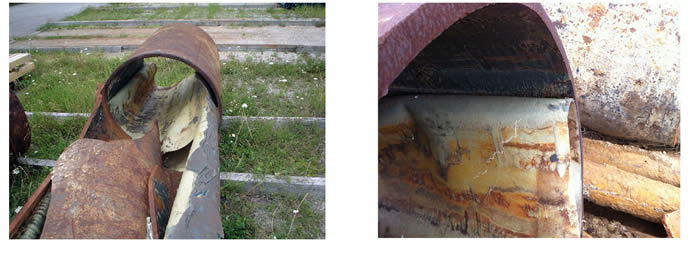A problem spotted in the cities of Vienna and Bratislava is that the quantity of water sent from the municipal systems mismatch with the quantity of water received by the consumers (houses, buildings and companies). The mismatch in the water readings is considerably high, in the range of 20% [Wasserwerke, 2009].
The Vienna Waterworks looked deeper into the problem and found that the main water loss points are caused by 100km of aged cast-iron pipelines with lead-joint sockets. The sockets were caulked up to the 1920's with a hemp pack and a lead ring. The swollen hemp pack ensured the sealing and the lead ring stabilized the hemp in the socket. Over the years the hemp pack decomposed and the lead ring was displaced by pipe movements leading eventually to leakage [Kottmann, 1997]. Nevertheless, the pipe segments from these pipelines are still in good metallurgical and static conditions, with an expected operability time of more than 50 years [C. Schoberleitner, 2013].

Lead joint socket with worn out hemp pack and lead ring.
Initial attempts to rehabilitate these types of pipes included operators inside the one meter diameter pipes. However, this creates a special situation that presents a safety and health risk to operators [S. Yang and Kwon, 2008].
Additionally, the cleaning process is time consuming and not optimal due to the challenging positions required by the operator and the cleaning tool to fully remove the corrosion from the pipe-joint.

Operator inside a 1000mm diameter cast-iron pipe, cleaning the pipe-joint.
In the city of Vienna a Silane Modified Polyether (SMP) sealant was applied to rehabilitate detected water-loss pipes. However, the system failed after 2 years in service; the investigation showed that both biological and environmental influences caused the failure [V. Archodoulaki and Werderitsch, 2010]. In this case, the inner sealant layer detached from the inner pipe surface.

Failed inner sealant system due to biological and environmental influences.
Other types of solutions, such as sleeve or 'patch' repairs, resin injection and mechanical joint sealing, were discarded due to high cost and the need of workers inside the pipe.
Currently, the applications of robots for the maintenance and rehabilitation of the pipeline utilities are considered as one of the most attractive solutions available. Since, no human operator is required inside the pipe and the robot can integrate multiple sensors, cameras and tools to inspect and repair [Roh et al., 2009].
Nevertheless, for an in-pipe robot to substitute a skilled human operator, pipe rehabilitation requires mechanisms with high degree of mobility, able to move along the pipelines, overcoming obstacles, extreme environments and clean and repair specific areas of the pipe with high accuracy [Li et al., 2007b].
Robotic repair systems, largely developed in Switzerland [Robotics, 2013] and Germany [Prokasro, 2013], are used mainly in gravity pipelines and comprise a grinding robot, such as Robocutter [robot, 2013b], KASRO robot [robot, 2013c], OptiCut [Optimess, 2013] or IMS Turbo cutter [IMSRobotics, 2013] and a filler robot [robot, 2013a] [Tech, 2013]. These commercial robotic platforms have several drawbacks, if considering to be used in fresh water pipes. The first downside is their integrated hydraulic system, which includes liquids that should not be used in fresh water pipelines. Additionally, their working pipe diameters are constrained to small-medium pipes, ranging from 200 to 800mm diameter. Moreover, commercial in-pipe cleaning robots commonly include a mobile robot similar to a vehicle with four wheels. Which, is not fixed to the center of the pipe when cleaning. Hence, when the robot is cleaning (grinding or milling) with its power tool, the stability of the robot relays only on the friction of the wheels to the pipe surface given by the robot's weight, creating a dangerous scenario in the fragile cast-iron pipes. Also, these robots do not include any suspension system to damp vibration forces from the cleaning tool, which may damage or even break the pipe.
